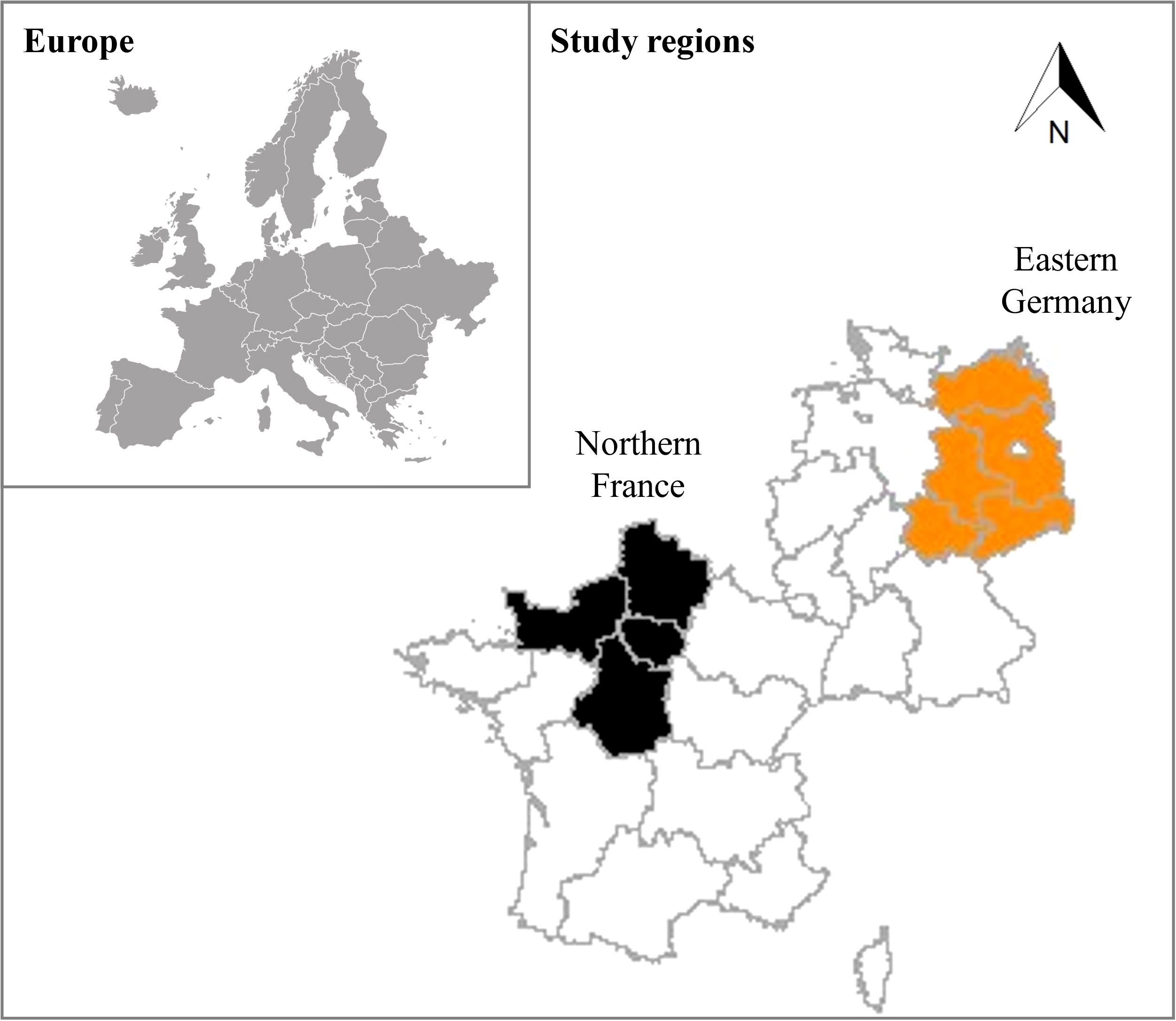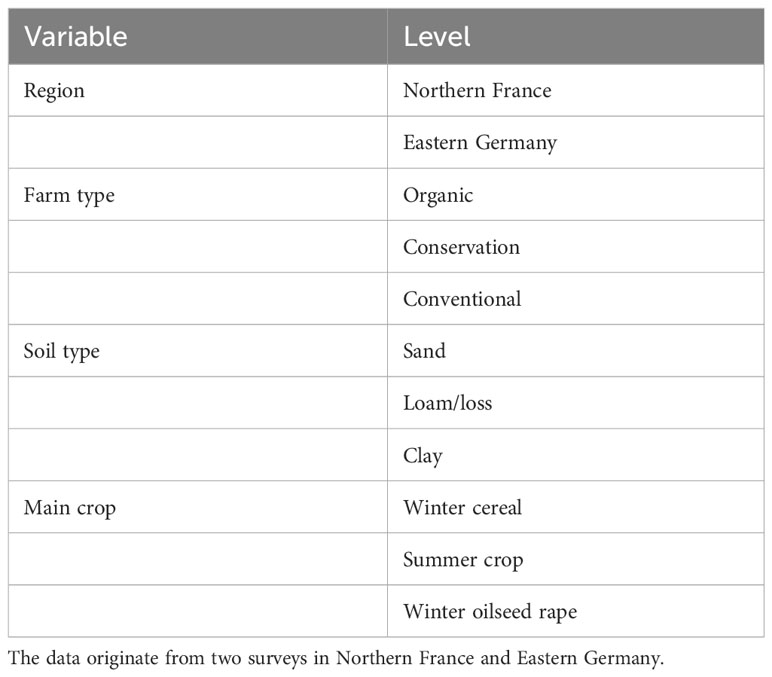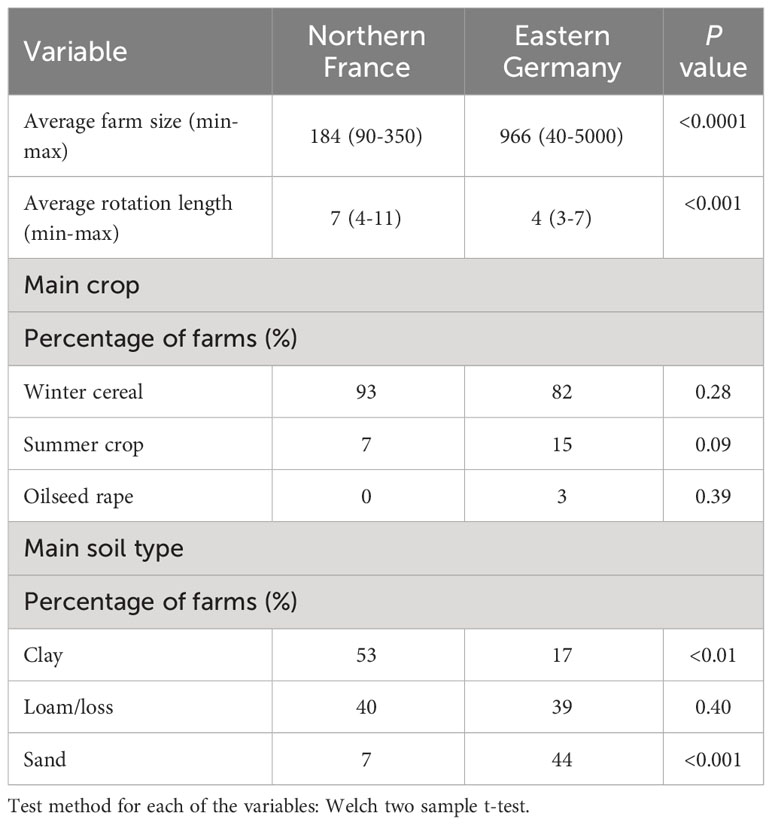- 1Faculty of Agricultural and Environmental Sciences, Crop Health, University of Rostock, Rostock, Germany
- 2National Research Institute for Agriculture, Food and the Environment (INRAE), L’UMR Agronomie, Palaiseau, France
European farmers are required to follow the transition towards sustainable agriculture and food systems. Perennial weed management without chemical herbicides and inversion tillage is challenging farmers. Questions arise to cope with these spreading weeds. Our study focuses on farmers’ perceptions and experiences of perennial weeds and their control in Northern France and Eastern Germany. A survey was developed to explore the situation regarding present concerns and future problems for perennial weed control. The survey conducted from winter 2020/21 to spring 2021 targeted conventional, conservation and organic farms. We found a high level of awareness for perennial weeds. On average, 80.0% of Northern French farmers and 65.9% of Eastern German farmers revealed present concerns about perennial weeds. Both, Northern French and Eastern German farmers perceived perennial weeds are more damaging to crop production than other pests. In both regions, the farmers considered Cirsium arvense (L.) Scop. as the most important perennial weed. While the majority of the Eastern German farmers observed field infestations of Elymus repens (L.) Gould, Northern French farmers more often reported Sonchus arvensis L. infestations. More than 50% of the farmers stated Rumex spp. infestations in Northern France and Eastern Germany. Interestingly, Eastern German farmers are more concerned about future perennial weed problems than Northern French farmers. The reasons for farmer’s future concerns are probably connected to the farming system. In both regions, conservation and conventional farmers heavily rely on herbicides for perennial weed control, however, more farms used the active ingredient glyphosate in Eastern Germany. Nonetheless, perennial weed control is a major concern for organic farmers in both regions. We conclude that optimizing and integrating non-chemical alternatives is promising in all farming systems. Research activities are required to provide farmers and extension services with novel and profitable perennial weed management practices.
1 Introduction
Perennial weeds reproduce both sexually, by setting seeds, and by clonal propagules (Håkansson, 2003). Creeping perennials ensure their lifeforms by subterranean storage organs, like roots, rhizomes or stolons (Anderson, 1999). Their clonal systems facilitate survival and spatial spread in arable fields by sprouting from these vegetative propagules (Harper, 1979; Navas and Goulard, 1991). Classified as geophytes that regenerate their above-ground plant biomass from subterranean sources, creeping perennial weeds may in general occur in different agroecosystems. Farming systems suffer from perennial weed infestations (Turner et al., 2007; Riemens et al., 2010; DeDecker et al., 2014). Some species are strongly adapted to arable land frequently disturbed (Tørresen et al., 2003; Bergkvist et al., 2017; Brandsæter et al., 2017).
The weediness and persistence of perennial weeds mainly depend on their vegetative growth and creeping root system (Håkansson, 1982) which allow the species to store nutritive elements and remain alive for several years (Buhler, 1994). For this reason, perennial weed management strategies require a multi-year approach, including specific preventive measures (e.g., crop rotation), cultural methods (e.g., competitive crops and varieties), and direct weed control tactics (e.g., use of herbicides, stubble management, mowing), which depend on the farm type and farm equipment (Mohler et al., 2021). Perennial weed control is one of the main challenges in organic farming (Bond and Grundy, 2001; Turner et al., 2007), more than in conventional farming. In organic farming systems, preventing perennial weeds by tillage practices, precisely displayed at the adequate moment, is important as synthetic chemical herbicides for weed control are excluded (Gruber et al., 2012). Cultural methods are specially appropriated to minimize gaps in which perennials may proliferate uncontrollably (Melander et al., 2012). Closing gaps in competition by subsidiary crops, e.g., cover crops, catch crops, either under-sown in the main crop or established after harvest, both for the purpose to perform competition in the period between main crops, is an important strategy to manage creeping perennial weeds (Vanhala et al., 2006; Bergkvist et al., 2010; Ringselle et al., 2015; Thomsen et al., 2015; Kolberg et al., 2018).
Such a systemic approach is different to the common trend in conventional farming where perennial weed control commonly includes direct control tactics (Harker and O'Donovan, 2013; Favrelière et al., 2020). Herbicides are central in the conventional approach to manage perennial weeds (McErlich and Boydston, 2014), while inversion tillage by a mouldboard plough and stubble cultivation in the intercropping period are crucial for non-chemical weed control (Brandsæter et al., 2017).
In conservation agriculture, the farmers rely on the same weed management practices as in conventional tillage systems but eliminate most or all of the tillage practices. Those inverting the soil are completely omitted. By reducing tillage kind, depth and frequency in conservation farming, perennial weeds became more prevalent than under conventional tillage systems (Pekrun and Claupein, 2004). Likely, conservation farming is depending much more on cultural (e.g., crop rotation, competitive cultivars, cover crops) and chemical control options (Soane et al., 2012). Indeed, conservation farmers design their cropping systems around the use of the non-selective active ingredient glyphosate (Andert et al., 2018; Pardo and Martínez, 2019; Beckie et al., 2020). Across European countries, one third of the acreage of annual cropping systems and half of the acreage of perennial tree crops are annually sprayed with glyphosate (data from 2013-2017, Antier et al., 2020). In Germany, detailed analyses of on-farm application patterns revealed that glyphosate was used for stubble and pre-sowing application on 34.0% of all fields (Andert et al., 2018). Among the French DEPHY farms (network, which represents more than 3,000 farms) with arable crops, 59% used glyphosate regularly or occasionally (Lapierre et al., 2019).
While the use of glyphosate remains by far the most effective practice for controlling perennial weeds in conventional and conservation farming, reduction strategies and acceptable alternatives are urgently required as glyphosate is expected to be increasingly restricted or even banned in Europe (Fogliatto et al., 2020; Kudsk and Mathiassen, 2020; Tataridas et al., 2022; Triantafyllidis et al., 2023). More and better agro-ecological weed management was likewise the specific goal of the European Directive 2009/128/EC on sustainable use of pesticides. Experimental results prove the efficacy of non-chemical control of perennial weeds, e.g., mechanical cutting (Bond and Grundy, 2001; Tiley, 2010), repeated mowing and hoeing (Graglia et al., 2006; Brandsæter et al., 2012; Bergkvist et al., 2017), stubble cultivation (Pekrun and Claupein, 2004), inversion tillage (Thomsen et al., 2015; Brandsæter et al., 2017), competition by cover crops (Vanhala et al., 2006; Kolberg et al., 2018) and vertical and horizontal cutting with minimum soil disturbance (Ringselle et al., 2018; Brandsæter et al., 2020).
Here, we present a survey to gain knowledge about farmers’ perennial weed management on-farm. We analyzed data from a survey among farmers in Northern France and Eastern Germany. We chose these study regions because the restriction or outright ban of the common active ingredient glyphosate is planned or occurring in France and Germany (Tosun et al., 2019; Beckie et al., 2020; Leonelli, 2023).
The 2017 EU-wide renewal of approval of glyphosate (currently approved until 15 December 2023) has caused considerable discontent among Member States, triggering the enactment of several national or regional measures. Despite Glyphosate was the most widely used herbicide active substance (9,700 tonnes in 2018 according to the Ministry of Ecological Transition and Solidarity 2019), France was the first country to announce an intention to ban glyphosate within three years (2017-20) (Kinniburgh, 2023). Nevertheless, instead of instituting a full ban on glyphosate in 2020, France merely announced new regulations which further restrict use authorizations for products containing glyphosate. In general though, France was the first European country with an overall pesticide reduction target of 50% (Ecophyto plan for 2018, proposed by the Grenelle Environment Forum in 2007), equivalent to the EU’s 2030 goal under the Farm to Fork Strategy (European Commission, 2020). Even France has failed to reduce pesticide use (Hossard et al., 2017), the policy adopted by the country (Ecophyto II and II+ plans for 2025) promotes the agro-ecological transition of its farms (Chauvel et al., 2022). Likewise, the German government’s Arable Farming Strategy 2035 sets out the clear direction for the reduction of pesticides (Bundesministerium für Ernährung und Landwirtschaft, 2021a). Starting 2020, the German government has also implemented a glyphosate reduction strategy and proposed to ban the use of plant protection products containing glyphosate in Germany after December 31, 2023 (Bundesministerium für Ernährung und Landwirtschaft, 2021b).
At the same time, many European farmers and farmers’ unions are vigorously opposed to the ban of glyphosate (Bjørnåvold et al., 2023). It is specially challenging for no-till agriculture because these systems can be difficult to set up and lack sustainable solutions for weed management without such type of herbicides (Kassam, 2019). Without glyphosate, fundamental changes in farming practices, and perennial weeds in particular are expected (Kudsk and Mathiassen, 2020) and a systemic approach is needed to design no herbicides systems (Chikowo et al., 2009; Reboud et al., 2019).
The objective of this study was to explore the practical experience of farmers. We wanted to answer the following questions:
1. Which practices do farmers apply to control perennial weeds?
2. Are farmers concerned or worried about perennial weeds?
3. How do farmers in Northern France and Eastern Germany perceive perennial weeds currently and in the future?
The analyses focus the regional and farm type level to see whether differences in production conditions and systems have an influence on farmers’ perceptions and experiences of perennial weeds and their control. Both regions chosen are characterized by arable cropping and include farms of different types.
2 Materials and methods
2.1 Study regions
Surveys were carried out among farmers in Northern France and Eastern Germany (Figure 1). In France, farmers in four regions surrounding Paris were surveyed: Normandy, Centre-Val de Loire, Ile de France and Hauts-de-France. In Germany, the survey was conducted in five federal states in eastern Germany: Saxony-Anhalt, Saxony, Thuringia, Brandenburg and Mecklenburg-Western Pomerania. The landscape of both regions is homogeneous and mainly characterized by large areas of cropland managed under conventional farming focused on winter wheat (Triticum æstivum L.), winter barley (Hordeum vulgare L.), and winter oilseed rapeseed (Brassica napus L.) (Andert et al., 2015; Ayerdi Gotor et al., 2020). The mean annual temperature between the years 1991 and 2020 was 10.8°C with mean annual precipitation of 712 liters per square meter in the region of Northern France (Météo France, SAFRAN, 2023), 9.1°C and 635 liters per square meter in the region of Eastern Germany (Deutscher Wetterdienst, 2022), respectively.
2.2 Surveys
We developed a questionnaire-based survey (see the Supporting Information) to elicit details about perennial weeds and their control practices in Northern France (15 farms) and Eastern Germany (41 farms). The surveys were conducted from winter 2020/21 to spring 2021 and were targeted at conventional, conservation and organic farms (Table 1). There were no incentives for farmers to participate in the survey. Participation was on a voluntary basis for both countries.
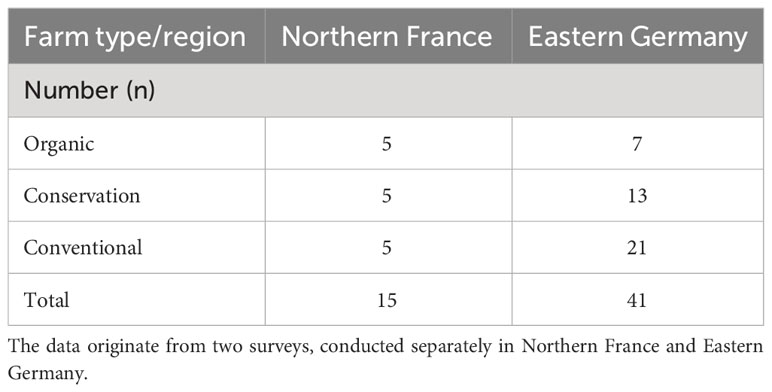
Table 1 Number of participants in the survey for the individual farm types organic, conservation and conventional.
With a mixture of closed (a question that presents respondents with pre-populated answer choices) and open (allow respondents to answer in open text format) question techniques, general and detailed questions regarding farm demographics, farmers’ perceptions of perennial weeds in arable crops and management of perennial weeds in arable crops. We widely used ‘Likert Scale Questions’ which offer a set of answer options that cover a range of opinions (Joshi et al., 2015).
In Northern France, 15 farmers who had to manage perennial weeds on their fields and who used cover crops (even if perennial management was not the main purpose of their cover crops) were surveyed. The Northern French online questionnaire consisted of questions on the role of cover crops, the ranking of perennial control methods, the presence and the evolution of perennial pressure over the years and the place of perennials in the ranking of the most problematic bio-aggressors. The Northern French farmers surveyed were pre-selected to have as many farmers in organic farming as in conventional farming and conventional farming with low or no tillage. Thus, among the 15 French farmers, there were: five in organic agriculture (no glyphosate, with tillage), five in soil conservation agriculture (two farmers) or in simplified cultural working (three farmers) (with glyphosate use, with low or no tillage) and five in conventional farming (with glyphosate use and tillage). The contact details of the French farmers were given with their agreement by a chamber of agriculture advisers, they were contacted by telephone to explain the objectives of the survey and to invite them to participate. We contacted 51 farmers and selected 15 of them, on several criteria: questions and problems with perennial weeds, presence of cover crops in their succession and balance between organic, no-till and conventional farmers. Those who accepted received the online questionnaire by email. These farmers were then interviewed at their homes or on their farms. During the French in-person interviews, the answers to the previous online questionnaire were reviewed with the farmers, to validate them, to answer the questions they had no time to answer and to clarify some questions they were not sure about. The personal interview also allowed us to characterize their farm (e.g., size of the farm, type of soil, description of the rotation). The Northern French farmers have not received any incentives for their voluntary participation.
In Eastern Germany, the anonymous questionnaire-based survey was published online, using the survey software EvaSys provided by Electric Paper Evaluationssysteme GmbH. The survey contained three main question categories, partially with sub-questions (a total of 25 questions). The web link to the survey was published in regional farming magazines. Participation in the survey was voluntary. The completed questionnaires were then returned to the University of Rostock and checked manually for non-response, incomplete and inconsistent responses (the values/answers entered for the questions must be consistent with the options). A total of 41 farmers clicked on the survey link. Information about response rates, e.g., how many farmer viewed the survey link and how many of them did actually respond are not available. The completion rate was 100%. We verified returned questionnaires by connecting the values/answers entered for the questions to make sure that a farmer did not fill out the questionnaire twice, the so-called ‘survey fraud’ (Singh and Sagar, 2021).
2.3 Data handling and analyses
The two data sets needed some adjustments to ensure comparability, while several questions of the Northern French and Eastern German surveys were similar, some parts were different. From the Northern French survey, only the ranking of perennial control methods, the presence and the evolution of perennial pressure over the years and the place of perennials in the ranking of the most problematic bio-aggressors were taken into account. The same restriction was applied to the Eastern German survey data.
A set of four questions were aimed at characterizing the demographic characteristics of participating farmers (Table 2). The ‘Likert Scale Questions’ focused on farmers’ perceptions of perennial weed infestations including ‘Ranking of perennial weeds in comparison to the three pests’, ‘Infestation of perennial weeds’, ‘Effectiveness of five methods to control perennial weeds’, ‘Concerns about perennial weeds’, ‘Estimation of future problems with perennial weeds’ (Table 3). Furthermore, farmers were asked to name ‘Most problematic perennial weeds’ as the open question.
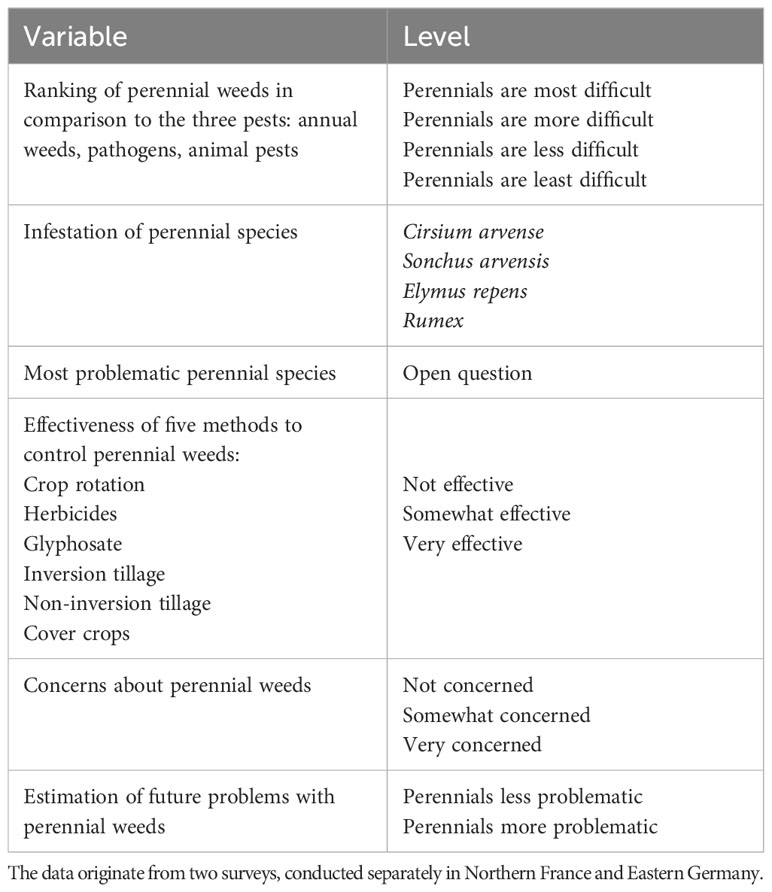
Table 3 Farmers’ perception variables with their respective levels, which were presented to the farmers within the survey.
Statistical analyses and scientific graphics were done in R, version 4.0.2 (R Core Team, 2022). The following packages were included: ‘agricolae’ (univariate analyses, de Mendiburu and Yaseen, 2020), vegan (multivariate analyses, Oksanen et al., 2014) and ggplot (graphs, Wickham, 2016).
Mean differences in farm and production characteristics, farmers′ perception of the perennial weed infestation (%) and damage potential of perennial weeds compared to other pests in crop production of Northern French and Eastern German farmers were compared by using Welch two sample t-test.
Differences in farm and production between the three farm types ‘conventional’, ‘conservation’ and ‘organic’ were tested with the non-parametric Kruskal-Wallis test.
Variation partitioning based on adjusted R2 in redundancy analysis (RDA) divided the variation of the ordinal response variables ‘Concerns about perennial weeds’ (Figure 2) and ‘Perceptions about perennial weeds’ (Figure 3) among the explanatory variables ‘farm size’, ‘farm type’, ‘region’, ‘soil type’ and ‘rotation length’. These variables were chosen to be influencing factors of a range of possible drivers for perennial weed infestation.
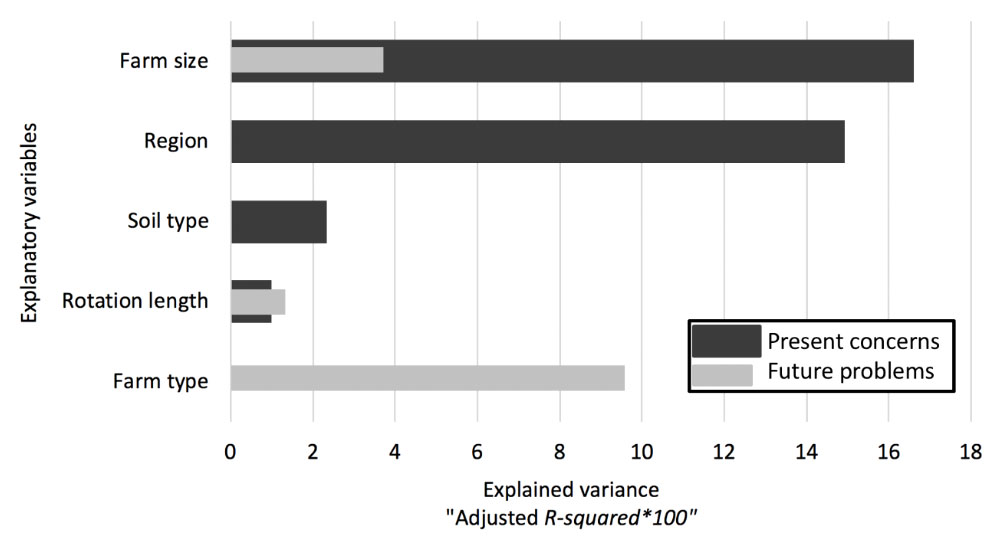
Figure 2 Explanatory variables (part of variance) that explain how farmers are concerned presently (grey bars) and in future (black bars) about perennial weeds: farm size, farm type, region, soil type, and rotation length given.
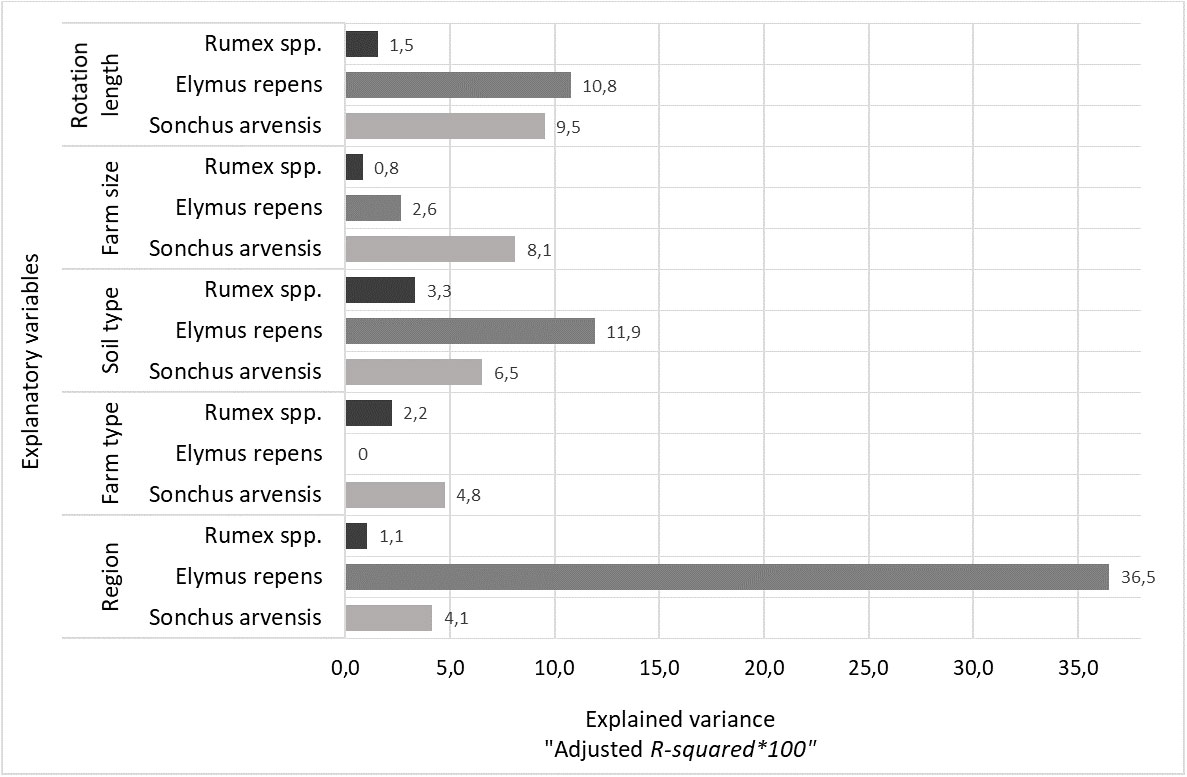
Figure 3 How farmers perceive Rumex spp., Elymus repens and Sonchus arvensis in fields explained by the variables farm size, farm type, region, soil type, and rotation length given as part of variance (%).
3 Results
3.1 Farm characteristics
Farms were significantly smaller in Northern France (184 ha) than in Eastern Germany (966 ha) (Table 4). We found a strong correlation (ρ=0.5) between farm size and region (Figure A1).
Significantly longer rotations were cropped on Northern French farms (seven years) than on Eastern German farms (four years). Winter cereals were the main crop in both regions. In Northern France, the mean on-farm soil type was clay and loam/loss, while in Eastern Germany it was sand and loam/loss.
On average, farms size of conservation (963 ha) and conventional (759 ha) was bigger than that of organic farms (444 ha) (Table 5). Crop rotations were longer on organic farms (six years) than on conservation (five years) and conventional (four years) farms. Winter cereals dominated the crop rotations of all farm types, the proportion of summer cereals was highest for organic farms (25%). The main soil type for the conservation and the conventional farm was loam/loss, and for organic farms sand, respectively.
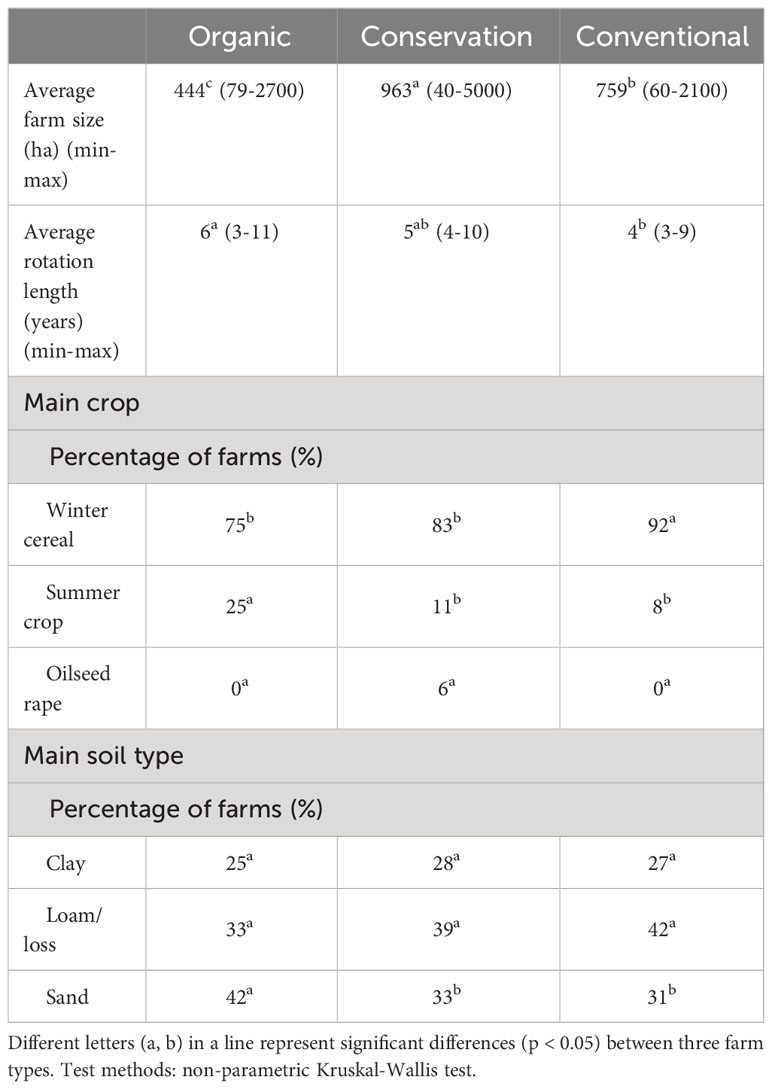
Table 5 Variables describing farm production situations of organic, conservation and conventional farmers participating in the survey.
3.2 How farmers control perennial weeds
In both regions, all conservation and conventional farmers used herbicides to control perennial weeds (Figure 4). More farms applicated the active ingredient glyphosate in Eastern Germany than in Northern France. No herbicides, including glyphosate, were applied in organic farms. Among the tillage practices, inversion tillage is common on conventional and organic farms in Northern France. Regardless of the farm type, cover crops were widely used in Northern France to control perennial weeds (100% of farmers) and, to a lesser extent, in Eastern Germany (65%).
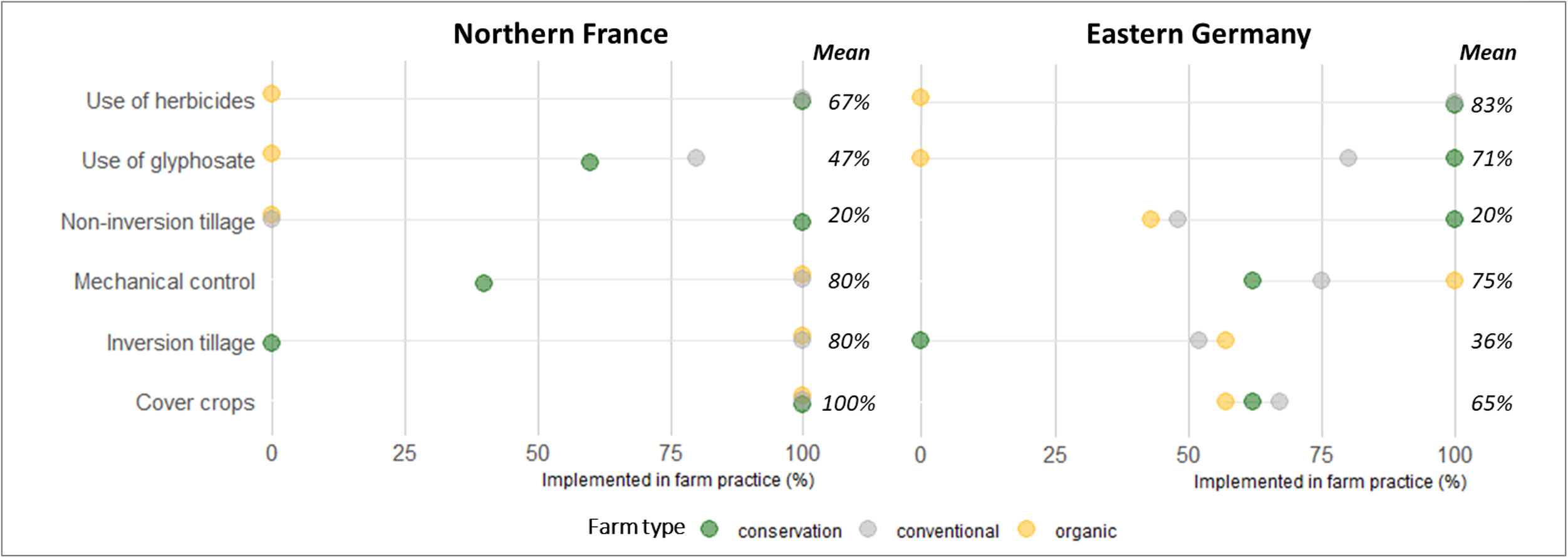
Figure 4 Implemented farm practices for control of perennial weeds of Northern French farmers and Eastern German farmers (Figure 1B) participating in the survey. Results were derived from a survey of 15 farmers in Northern France and 41 farmers in Eastern Germany. Farmers’ farm practices were grouped per region and farm type.
3.3 How farmers perceive perennial weeds and their management
In both regions, the farmers considered C. arvense as the most important perennial weed (Figure 5). More than 80% of the Eastern German farmers observed field infestations of E. repens, while only 20% of Northern French farmers confirmed the species. In contrast, Northern French farmers more often reported S. arvensis infestations. More than 50% of the farmers stated Rumex spp. infestations in Northern France and Eastern Germany.

Figure 5 How farmers perceive creeping perennial weeds infestation. * represents significant differences (p < 0.05) between the regions (Northern France, Eastern Germany) and farm types (conventional, conservation, organic).
Farmers perceived perennial weeds as more damaging for crop production than other pests (e.g., annual weeds, plagues, diseases) (Figure 6). Particularly, Northern French farmers (67%) rated perennial weeds as more damaging. 25% and 13% of Eastern German and Northern French farmers, respectively, ranked perennial weeds as the most damaging pest group. Among the three farm types, farmers anticipated the potential damage of perennial weeds similarly (Figure 6).
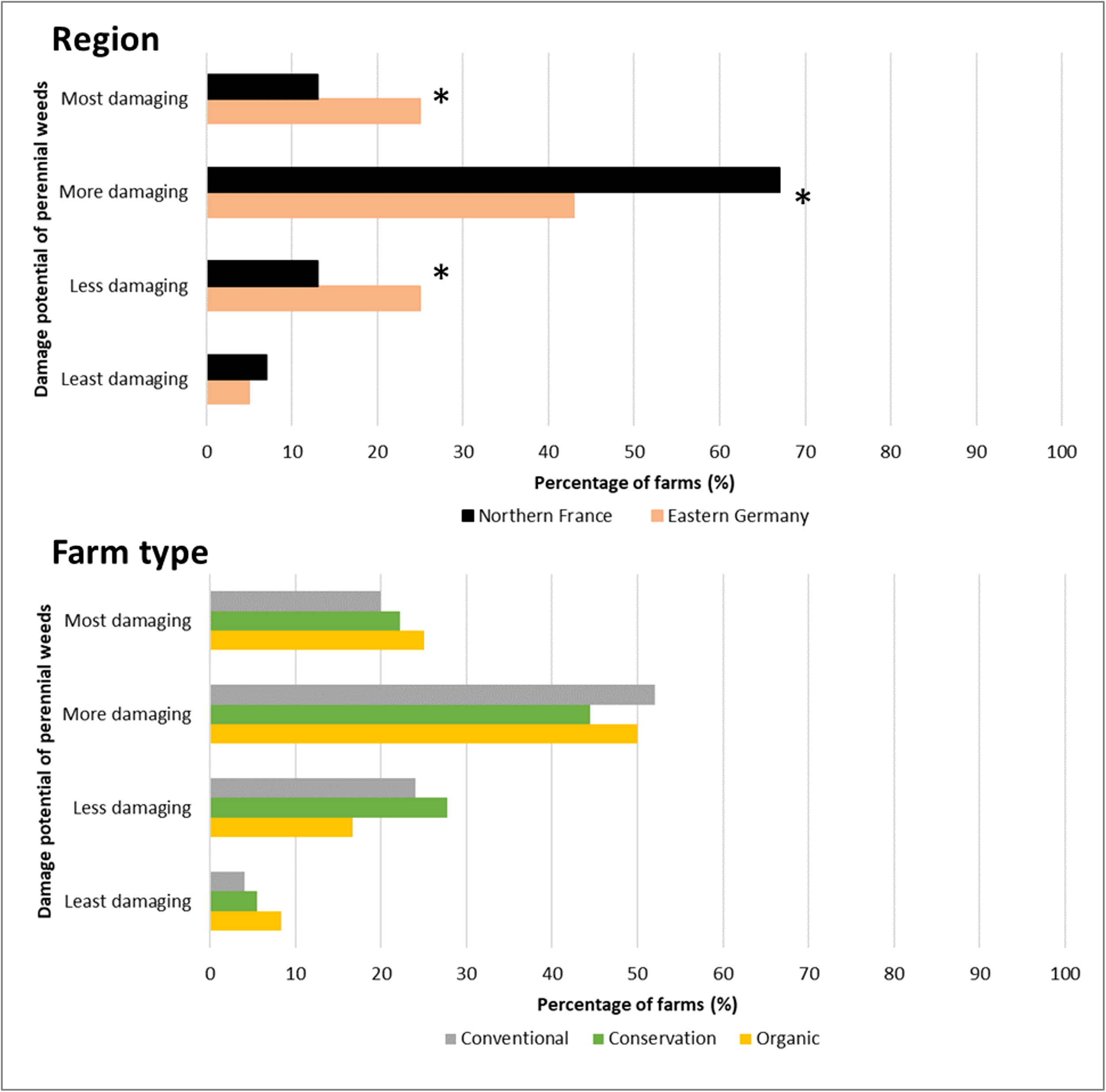
Figure 6 How farmers perceive the damage potential of creeping perennial weeds compared to other pests in crop production (e.g., annual weeds, animal pests, diseases). * represents significant differences (p < 0.05) between the regions (Northern France, Eastern Germany) and farm types (conventional, conservation, organic).
Generally, farmers experienced crop rotation, inversion tillage and herbicide use as effective practices to control perennial weeds (Figure 7). Particularly, conventional and conservation farmers perceived the use of herbicides as very effective. In contrast, cover crops were mentioned as only somewhat effective. We found significant differences between Northern France and Eastern Germany in farmers’ perceptions of how effective non-inversion tillage is to control perennials. Non-inversion tillage is expected to be not effective (French farmers).
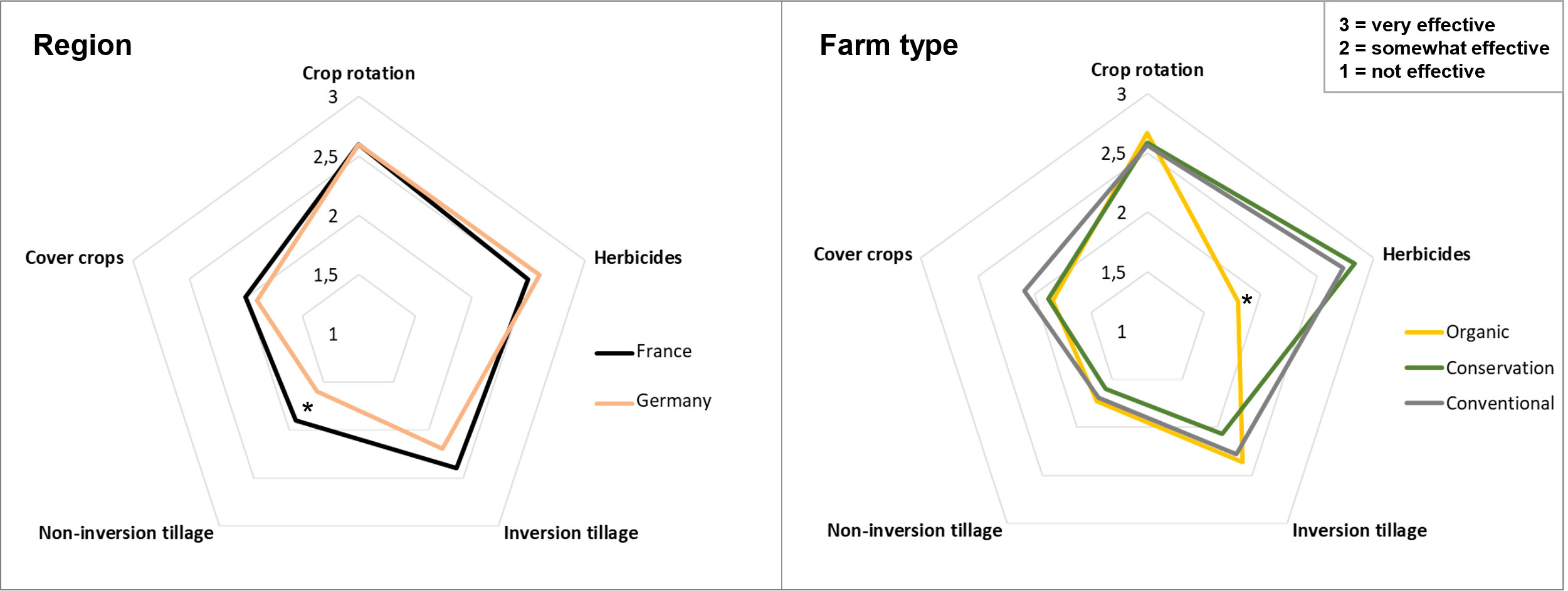
Figure 7 Farmers’ perceptions of the effectiveness (‘not effective’, ‘somewhat effective’ or ‘very effective’) of different management methods (crop rotation, herbicides, inversion tillage, non-inversion tillage and cover crops) for the control of perennial weeds. Farmers’ perceptions were grouped per region and farm type. * represents significant differences (p < 0.05) between farm types.
3.4 Explaining how farmers perceive perennial weeds with farm and management characteristics
Overall, explanatory variables explained a total of 34.9% of the variance in farmers’ present concerns, and 12% for future problems respectively (Figure 2). Regarding present concerns, the variable farm size explained most of the variance (16.6%). Region explained an additional 14.9% in the farmer perceptions and another 2.3% of the variance resulted from the factor soil type, for rotation length 1% respectively. On average, 80% of Northern French farmers and 65.9% of Eastern German farmers revealed present concerns about perennial weeds (Table 6).

Table 6 How farmers are concerned presently and in future about perennial weeds per region and farm type.
The variable farm type had the largest effect (8.1%) on farmers’ perceptions of future perennial weed problems. In Northern France, more organic and conservation than conventional farmers fear future perennial weed problems (Table 6). In general, Eastern German farmers are more afraid about future perennial weed problems than Northern French farmers. Future concerns about perennial weeds in Eastern Germany were not significantly depending on the farm types (Table 6).
The farm size and rotation length only explained 3.2% and 1.2% respectively (Figure 2).
As each of the French farmers confirmed C. arvense infestations, relevant factors for C. arvense field infestation were only analysed for German farmer participants. The rotation length had the largest effect on the C. arvense infestation (16.1%). Farm size affected C. arvense field infestations equally strongly as the soil type (13.5% and 12.8% respectively). There was no effect by farm type.
The other weed species (S. arvensis, E. repens and Rumex spp.) responded differently to explanatory variables (Figure 3). For E. repens, almost 60% of the variance was pure region effects (36.5% net effect). Soil type explained an additional 11.9% in the E. repens infestation and another 10.8% of the variance resulted from the factor rotation length. The rotation length explained most of the variance for S. arvensis infestation (9.5%). Farm size showed a stronger effect on S. arvensis variation than soil type, farm type and region. The variables soil type (3.3%) and farm type (2.2%) explained most of the Rumex spp. field infestation. The other variables only explained 0.8% (farm size), 1.1% (region) and 1.5% (rotation length).
4 Discussion
This study analysed farmers’ perceptions and experiences on perennial weeds and their control in Northern France and Eastern Germany. Opinion surveys offer comprehensive pictures of farmers’ appraisements (Ulber and Rissel, 2018; Andert et al., 2019; Lanker et al., 2020; Matousek et al., 2022).
We aimed to include organic, conservation and conventional farmers from two European countries into our study in order to reveal the range of variations in perennial weed management.
We found a high level of awareness for perennial weeds. On average, 80.0% of Northern French farmers and 65.9% of Eastern German farmers revealed present concerns about perennial weeds (Table 6). Both, Northern French and Eastern German farmers perceived perennial weeds as more damaging to crop production than other pests.
Sample sizes in our study differed between the study regions Northern France and Eastern Germany. The questionnaire-based survey among Eastern German farmers allowed the acquisition of a larger sample size with lower effort compared to the French survey. A potential limitation of the present study is the sample size of participants (Andrade, 2020); increasing the number of respondents to consolidate our findings would further support the study results. Matousek et al. (2022), describe that the recruitment of participants is effortful because many farmers are expected to be blamed for using glyphosate-based herbicides, and thus, were probably sceptical about the related perennial weed control topic. Therefore, our results provide unique indications for future perennial weed management in Europe. Another limitation of our study is that voluntary recruiting participant in the study region Eastern Germany can cause an unwanted pre-selection of participants. This is a general weakness in questionnaire-based samples (Wu et al., 2022). Pre-selecting the Northern French farmers’ by the criterion that they had to manage perennial weeds on their fields, on the other hand may have overestimated the creeping perennial weeds and their need to control. Nevertheless, the findings of this study offer valuable new insight how farmers perceive and control perennial weeds currently and in the future. Moreover, because of their concern about the perennial weeds, farmers could more easily provide a sound advice and share their expertise on solutions to manage the weeds, by soil disturbance or cover crops.
The ability to reproduce vegetatively is a unique characteristic among arable weeds that promotes the survival of perennial species over winters, dry seasons or other unfavorable periods to growth (Håkansson, 1982). Farmers’ awareness of perennial weeds and their suitable control tactics are especially important because the infestations are likely to spread rapidly, and have negative impact lasting several years if effective management is not undertaken. Overall, 100% of the surveyed farmers listed C. arvense as the most important perennial weed species, and more than 50% of farmer participants stated Rumex spp. infestations (Figure 4). The two species are troublesome weeds in both arable lands and grasslands (mainly pastures), but Rumex spp. are also early colonizers of many disturbed areas (Zaller, 2004; Favrelière et al., 2020). Interestingly, field infestations of E. repens are most prominent among farmers in Eastern Germany. Probably, E. repens infestations are favored by common reduced tillage, cereal-dominated crop rotations and high-intensive nitrogen fertilization in this region (Andreasen and Skovgaard, 2009; Andert et al., 2016; Ringselle et al., 2020). Northern French farmers more often reported S. arvensis infestations. This species is especially known and problematic in Nordic countries in arable crops and, to some extent, in grasslands (Vanhala et al., 2006; Tørresen et al., 2010; Andersson et al., 2013). Whilst, temperature and concentration of CO2 are increasing globally, S. arvensis reacts with higher biomass and reproduction (Tørresen et al., 2019). For this reason, this species is a candidate to profit from climate change (Tørresen et al., 2019), and thus, might potentially spread to other regions.
One of the most interesting results of our study is that farmers in Eastern Germany are more concerned about future perennial weed problems than those in Northern France. We attribute the differences in farmers’ concerns to regional production differences in our study. The farms were significantly smaller and crop rotations were longer in Northern France than in Eastern Germany (Table 4). Perennial weed control of Eastern German farmers is mainly based on chemical herbicide use, while inversion soil disturbance and competition by cover crops is widely used by the surveyed Northern French farmers (Figure 4). As introduced, disturbance and competition are two important processes which are used to manage creeping perennials weeds non-chemically. Obviously, farmers in Northern France are aware of these agro-ecological weed control tools, designing their cropping systems to be less dependent on herbicides. These cropping systems are expected to be more resilient for future farming.
Farmers in the two regions are differently concerned about perennial weeds in the future. In each region, however, farmers’ perceptions of future perennial weed problems were mainly explained by differences between the farm types (Figure 2). The reasons for farmers’ future concerns are fairly obvious and connected to the farming system. In both regions, conservation and conventional farmers heavily rely on herbicides for perennial weed control (Figure 1). Indeed, Andert et al. (2022) observed that C. arvense was more common in fields less frequently treated with glyphosate. Currently, there is a lack of effective alternatives to glyphosate to manage conservation fields without disturbing the soil in the long term (Nichols et al., 2015), because even direct perennial weed control by selective herbicides might be less effective than in the past decades. Tavaziva et al. (2019) stated that 100% of the recommended MCPA (2-methyl-4-chlorophenoxyacetic acid) dosage is required to obtain the strongest control of C. arvense. This finding is in accordance with results from a study of C. arvense and S. arvensis where less reduced herbicide doses of MCPA gave an increase in above-ground biomass as compared with recommended dose (Fogelfors and Lundkvist, 2008).
The demand for reducing both selective and non-selective herbicides will increase the complexity of farm management and decision-making (Rossi et al., 2012; Jussaume et al., 2022) for perennial weed management in conservation and conventional farming. However, as expected and already described by other authors, perennial weed control is a major concern for organic farmers (Turner et al., 2007; Melander et al., 2012; Brandsæter et al., 2020). Likewise, in Northern France and Eastern Germany, organic farmers are concerned about future perennial weed problems (Table 6), as direct physical weeding techniques, like harrowing, inter-row hoeing, brushing and even flaming the crops, have not shown to be effective to control perennials (Melander et al., 2005). Indeed, creeping perennial weeds might threaten the future of organic cereal production (Salonen et al., 2013; McErlich and Boydston, 2014), especially under reduced-tillage (Armengot et al., 2015). Thus, controlling perennial weed is a continuous challenge for farms of all types.
While inversion tillage is of paramount importance to reduce perennial weed infestations, many farmers want to reduce the intensive soil tillage as it consumes much energy and labor costs, compacts the ground and diminishes soil biological activities (Cooper et al., 2016; Zikeli and Gruber, 2017). New ways of applying belowground disturbance without turning the soil include mechanical tools which cut roots/rhizomes horizontally (linked to weed species with deep root systems) or vertically (linked to weed species with shallow root systems) (Thomsen et al., 2015; Brandsæter et al., 2017; Ringselle et al., 2018; Brandsæter et al., 2020; Weigel and Gerowitt, 2022). These techniques may assist to overcome the trade-off between perennial weed control and reduced tillage. As cover crops are already established in farming systems, it will be promising to further develop control tactics which combine non-inversion tillage practices and cover crops. Developing agro-ecological weed management techniques and successfully implementing these in farming systems for consistent perennial weed control will be important for long-term viability of agricultural systems. Organic farmers could help in the way to design new systems. Long-term experiments on weed management demonstrate that it is possible to reduce herbicides dependencies, if a systemic and agroecological approach is engaged (Deytieux et al., 2012; Lechenet et al., 2017). Indeed, the unique characteristics of perennial weeds complicate the task of reducing or even eliminating the use of herbicides. However, the implementation of non-chemical perennial weed control might become an example to transform agriculture, shaping the approach to ensuring food security and fostering sustainable methods of production (Vanbergen et al., 2020).
5 Conclusions
Farmers in Northern France and Eastern Germany are concerned about perennial weeds in the future. The demand for reducing herbicides will increase the complexity of perennial weed control for conservation and conventional farming. The outright ban of glyphosate could completely challenge the development of conservation agriculture in which the management of perennial weeds highly depends on this active ingredient. Up to now, perennial weed control was especially a major obstacle for organic farming. However, this is expected to change considerably in the future, because perennial weed control might become a challenge to all farmers.
The ability to reproduce vegetatively of those weeds promotes them an uncredible capability to survive over winters, dry seasons or other unfavorable periods and therefore they are a sort of key indicators to assess the successfulness of “no-less herbicides systems”. These specific weeds may give the chance to farmers-advisers to re-design their crop management in a systemic way, all the more as “easy herbicides solutions” do not exist anymore. Therefore, integrating and optimizing non-chemical weed control alternatives is required in all farming systems. We conclude, that perennial weeds as ‘difficult-to-control weeds’ should take a special position in National Action Plans of the EU Member States. Research activities should provide all farmers and extension services with novel and profitable perennial weed management practices. Moreover, the EU countries should long-term monitor perennial weeds and the consequences of their control.
Data availability statement
The raw data supporting the conclusions of this article will be made available by the authors, without undue reservation.
Author contributions
Conceptualization, SA, MV-M, and BG; Data curation, MH and JG; Formal analysis, SA, MH, and JG; Funding acquisition, SA, MV-M, and BG; Supervision, MV-M and BG; Validation, SA and JG; Visualization, SA and MH; Writing—original draft, SA; Writing—review and editing, SA, JG, MV-M, and BG. All authors contributed to the article and approved the submitted version.
Funding
This research was part of the project “AC/DC-weeds - Applying and Combining Disturbance and Competition for an agro-ecological management of creeping perennial weeds” funded by the European Union’s Horizon 2020 research and innovation programme under grant agreement No 771134. The project “AC/DC-weeds was carried out under the ERA-NET Cofund SusCrop (Grant N°771134), being part of the Joint Programming Initiative on Agriculture, Food Security and Climate Change (FACCE-JPI). The German part is funded by DFG (Deutsche Forschungsgemeinschaft), GE 558/3-1.
Acknowledgments
We would like to express many thanks to all the farmers in the regions Northern France and Eastern Germany who participated in the survey.
Conflict of interest
The authors declare that the research was conducted in the absence of any commercial or financial relationships that could be construed as a potential conflict of interest.
Publisher’s note
All claims expressed in this article are solely those of the authors and do not necessarily represent those of their affiliated organizations, or those of the publisher, the editors and the reviewers. Any product that may be evaluated in this article, or claim that may be made by its manufacturer, is not guaranteed or endorsed by the publisher.
Supplementary material
The Supplementary Material for this article can be found online at: https://www.frontiersin.org/articles/10.3389/fagro.2023.1247277/full#supplementary-material
References
Anderson W. P. (1999). Perennial weeds: Characteristics and identification of selected herbaceous species (Ames: Iowa State University Press).
Andersson L., Boström U., Forkman J., Hakman I., Liew J., Magnuski E. (2013). Sprouting capacity from intact root systems of Cirsium arvense and Sonchus arvensis decrease in autumn. Weed Res. 53, 183–191. doi: 10.1111/wre.12013
Andert S., Bürger J., Gerowitt B. (2015). On-farm pesticide use in four Northern German regions as influenced by farm and production conditions. Crop Prot. 75, 1–10. doi: 10.1016/j.cropro.2015.05.002
Andert S., Bürger J., Mutz J.-E., Gerowitt B. (2018). Patterns of pre-crop glyphosate use and in-crop selective herbicide intensities in Northern Germany. Eur. J. Agron. 97, 20–27. doi: 10.1016/j.eja.2018.04.009
Andert S., Bürger J., Stein S., Gerowitt B. (2016). The influence of crop sequence on fungicide and herbicide use intensities in North German arable farming. Eur. J. Agron. 77, 81–89. doi: 10.1016/j.eja.2016.04.003
Andert S., Mol F., Koning L., Gerowitt B. (2022). Weed response in winter wheat fields on a gradient of glyphosate use in the recent past. Agric. Ecosyst. Environ. 333, 107977. doi: 10.1016/j.agee.2022.107977
Andert S., Mutz J.-E., Wiese A., de Mol F., Steinmann H.-H., Gerowitt B. (2019). Farmers’ statements are reliable – Comparing two different data sources about glyphosate use in Germany. Crop Prot. 124, 104876. doi: 10.1016/j.cropro.2019.104876
Andrade C. (2020). The limitations of online surveys. Indian J. Psychol. Med. 42, 575–576. doi: 10.1177/0253717620957496
Andreasen C., Skovgaard I. M. (2009). Crop and soil factors of importance for the distribution of plant species on arable fields in Denmark. Agric. Ecosyst. Environ. 133, 61–67. doi: 10.1016/j.agee.2009.05.003
Antier C., Kudsk P., Reboud X., Ulber L., Baret P. V., Messéan A. (2020). Glyphosate use in the European agricultural sector and a framework for its further monitoring. SUSTDE 12, 5682. doi: 10.3390/su12145682
Armengot L., Berner A., Blanco-Moreno J. M., Mäder P., Sans F. X. (2015). Long-term feasibility of reduced tillage in organic farming. Agron. Sustain. Dev. 35, 339–346. doi: 10.1007/s13593-014-0249-y
Ayerdi Gotor A., Marraccini E., Leclercq C., Scheurer O. (2020). Precision farming uses typology in arable crop-oriented farms in northern France. Precis. Agric. 21, 131–146. doi: 10.1007/s11119-019-09660-y
Beckie H. J., Flower K. C., Ashworth M. B. (2020). Farming without glyphosate? Plants 9, 96. doi: 10.3390/plants9010096
Bergkvist G., Adler A., Hansson M., Weih M. (2010). Red fescue undersown in winter wheat suppresses Elytrigia repens. Weed Res. 50, 447–455. doi: 10.1111/j.1365-3180.2010.00789.x
Bergkvist G., Ringselle B., Magnuski E., Mangerud K., Brandsaeter L. O. (2017). Control of Elymus repens by rhizome fragmentation and repeated mowing in a newly established white clover sward. Weed Res. 57, 172–181. doi: 10.1111/wre.12246
Bjørnåvold A., David M., Mermet-Bijon V., Beaumais O., Crastes Dit Sourd R., van Passel S., et al. (2023). To tax or to ban? A discrete choice experiment to elicit public preferences for phasing out glyphosate use in agriculture. PloS One 18, e0283131. doi: 10.1371/journal.pone.0283131
Bond W., Grundy A. C. (2001). Non-chemical weed management in organic farming systems. Weed Res. 41, 383–405. doi: 10.1046/j.1365-3180.2001.00246.x
Brandsæter L. O., Goul Thomsen M., Wærnhus K., Fykse H. (2012). Effects of repeated clover undersowing in spring cereals and stubble treatments in autumn on Elymus repens, Sonchus arvensis and Cirsium arvense. Crop Prot. 32, 104–110. doi: 10.1016/j.cropro.2011.09.022
Brandsæter L. O., Mangerud K., Andersson L., Børresen T., Brodal G., Melander B. (2020). Influence of mechanical weeding and fertilisation on perennial weeds, fungal diseases, soil structure and crop yield in organic spring cereals. Acta Agric. Scand. 70, 318–332. doi: 10.1080/09064710.2020.1728371
Brandsæter L. O., Mangerud K., Helgheim M., Berge T. W. (2017). Control of perennial weeds in spring cereals through stubble cultivation and mouldboard ploughing during autumn or spring. Crop Prot. 98, 16–23. doi: 10.1016/j.cropro.2017.03.006
Buhler D. (1994). Perennial weed populations after 14 years of variable tillage and cropping practices. Weed Sci. 42, 205–209. Available at: https://www.jstor.org/stable/4045395.
Bundesministerium für Ernährung und Landwirtschaft (2021a) Ackerbaustrategie 2035. Available at: https://www.bmel.de/SharedDocs/Downloads/DE/Broschueren/ackerbaustrategie2035.html;jsessionid=B71B203DC62DAFC38875C88804135FE3.live921 (Accessed October 20, 2021).
Bundesministerium für Ernährung und Landwirtschaft (2021b). Fünfte Verordnung zur Änderung der Pflanzenschutz-Anwendungsverordnung. Available at: https://www.bmel.de/SharedDocs/Downloads/DE/Glaeserne-Gesetze/Kabinettfassung/5-aenderung-pflanzenschutz-anwendungs-vo.pdf?__blob=publicationFile&v=2.
Chauvel B., Gauvrit C., Guillemin J.-P. (2022). From sea salt to glyphosate salt: a history of herbicide use in France. Adv. Weed Sci. 40, 1–16. doi: 10.51694/AdvWeedSci/2022;40:seventy-five008
Chikowo R., Faloya V., Petit S., Munier-Jolain N. M. (2009). Integrated Weed Management systems allow reduced reliance on herbicides and long-term weed control. Agric. Ecosyst. Environ. 132, 237–242. doi: 10.1016/j.agee.2009.04.009
Cooper J., Baranski M., Stewart G., Nobel-de Lange M., Bàrberi P., Fließbach A., et al. (2016). Shallow non-inversion tillage in organic farming maintains crop yields and increases soil C stocks: a meta-analysis. Agron. Sustain. Dev. 36, 1–20. doi: 10.1007/s13593-016-0354-1
DeDecker J. J., Masiunas J. B., Davis A. S., Flint C. G. (2014). Weed management practice selection among Midwest U.S. Organic growers. Weed Sci. 62, 520–531. doi: 10.1614/WS-D-13-00138.1
de Mendiburu F., Yaseen M. (2020). agricolae: Statistical Procedures for Agricultural Research. (R package version 1.4.0). Available at: https://myaseen208.github.io/agricolae/https://cran.r-project.org/package=agricolae.
Deutscher Wetterdienst (2022) Vieljährige Mittelwerte. Available at: https://www.dwd.de/DE/leistungen/klimadatendeutschland/vielj_mittelwerte.html (Accessed January 06, 2023).
Deytieux V., Nemecek T., Freiermuth Knuchel R., Gaillard G., Munier-Jolain N. M. (2012). Is Integrated Weed Management efficient for reducing environmental impacts of cropping systems? A case study based on life cycle assessment. Eur. J. Agron. 36, 55–65. doi: 10.1016/j.eja.2011.08.004
European Commission (2020) Farm to Fork Strategy: For a fair, healthy and environmentally-friendly food system. Available at: https://ec.europa.eu/food/horizontal-topics/farm-fork-strategy_de (Accessed October 20, 2021).
Favrelière E., Ronceux A., Pernel J., Meynard J.-M. (2020). Nonchemical control of a perennial weed, Cirsium arvense, in arable cropping systems. A review. Agron. Sustain. Dev. 40, 1–17. doi: 10.1007/s13593-020-00635-2
Fogelfors H., Lundkvist A. (2008). Selection in Cirsium arvense (L.) Scop. and Sonchus arvensis L. Susceptibility to MCPA on different types of farmland in Sweden. Acta Agric. Scand. 58, 82–87. doi: 10.1080/09064710701228346
Fogliatto S., Ferrero A., Vidotto F. (2020). Current and future scenarios of glyphosate use in Europe: Are there alternatives? Adv. Agron. 163, 219–278. doi: 10.1016/bs.agron.2020.05.005
Graglia E., Melander B., Jensen R. K. (2006). Mechanical and cultural strategies to control Cirsium arvense in organic arable cropping systems. Weed Res. 46, 304–312. doi: 10.1111/j.1365-3180.2006.00514.x
Gruber S., Pekrun C., Möhring J., Claupein W. (2012). Long-term yield and weed response to conservation and stubble tillage in SW Germany. Soil Tillage Res. 121, 49–56. doi: 10.1016/j.still.2012.01.015
Håkansson S. (1982). “Multiplication, growth and persistence of perennial weeds,” in Biology and ecology of weeds, vol. 2 . Eds. Holzner W., Numata M. (Dordrecht: Springer). Geobotany. doi: 10.1007/978-94-017-0916-3_11
Håkansson S. (2003). Weeds and weed management on arable land: An ecological approach (Wallingford, Oxon, UK, Cambridge: MA: CABI Pub).
Harker K. N., O'Donovan J. T. (2013). Recent weed control, weed management, and integrated weed management. Weed Technol. 27, 1–11. doi: 10.1614/WT-D-12-00109.1
Hossard L., Guichard L., Pelosi C., Makowski D. (2017). Lack of evidence for a decrease in synthetic pesticide use on the main arable crops in France. Sci. Total Environ. 575, 152–161. doi: 10.1016/j.scitotenv.2016.10.008
Joshi A., Kale S., Chandel S., Pal D. (2015). Likert scale: explored and explained. BJAST 7, 396–403. doi: 10.9734/BJAST/2015/14975
Jussaume R. A., Dentzman K., Frisvold G., Ervin D., Owen M. (2022). Factors that influence on-farm decision-making: evidence from weed management. Soc Nat. Resour 35, 527–546. doi: 10.1080/08941920.2021.2001123
Kassam A. (2019). “Integrating conservation into agriculture,” in Innovations in Sustainable Agriculture (Cham: Springer), 27–41.
Kinniburgh F. (2023). The politics of expertise in assessing alternatives to glyphosate in France. Environ. Sci. Policy 145, 60–72. doi: 10.1016/j.envsci.2023.01.017
Kolberg D., Brandsæter L. O., Bergkvist G., Solhaug K. A., Melander B., Ringselle B. (2018). Effect of rhizome fragmentation, clover competition, shoot-cutting frequency, and cutting height on quackgrass (Elymus repens). Weed Sci. 66, 215–225. doi: 10.1017/wsc.2017.65
Kudsk P., Mathiassen S. K. (2020). Pesticide regulation in the European Union and the glyphosate controversy. Weed Sci. 68, 214–222. doi: 10.1017/wsc.2019.59
Lanker M., Bell M., Picasso V. D. (2020). Farmer perspectives and experiences introducing the novel perennial grain Kernza intermediate wheatgrass in the US Midwest. Renew. Agric. Food Syst. 35, 653–662. doi: 10.1017/S1742170519000310
Lapierre M., Sauquet A., Subervie J. (2019). “Improving farm environmental performance through technical assistance: empirical evidence on pesticide use," Working Papers 2019.19, FAERE - French Association of Environmental and Resource Economists. Available at: https://ideas.repec.org/p/fae/wpaper/2019.19.html.
Lechenet M., Dessaint F., Py G., Makowski D., Munier-Jolain N. (2017). Reducing pesticide use while preserving crop productivity and profitability on arable farms. Nat. Plants. 3, 1–6. doi: 10.1038/nplants.2017.8
Leonelli G. C. (2023). The glyphosate saga continues: ‘Dissenting’ Member states and the European way forward. TEL 12, 200–224. doi: 10.1017/S2047102522000188
Matousek T., Mitter H., Kropf B., Schmid E., Vogel S. (2022). Farmers' Intended weed management after a potential glyphosate ban in Austria. Environ. Manage. 69, 871–886. doi: 10.1007/s00267-022-01611-0
McErlich A. F., Boydston R. A. (2014). “Current state of weed management in organic and conventional cropping systems,” in Automation: The Future of Weed Control in Cropping Systems. Eds. Young S. L., Pierce F. J. (Dordrecht: Springer Netherlands), 11–32.
Melander B., Holst N., Rasmussen I. A., Hansen P. K. (2012). Direct control of perennial weeds between crops – Implications for organic farming. Crop Prot. 40, 36–42. doi: 10.1016/j.cropro.2012.04.029
Melander B., Rasmussen I. A., Bàrberi P. (2005). Integrating physical and cultural methods of weed control— examples from European research. Weed Sci. 53, 369–381. doi: 10.1614/WS-04-136R
Mohler C. L., Teasdale J. R., DiTommaso A. (2021). Manage weeds on your farm: A guide to ecological strategies (College Park: Sustainable Agriculture Research & Education (SARE). SARE handbook series 16.
Navas M.-L., Goulard M. (1991). Spatial pattern of a clonal perennial weed, Rubia peregrina (Rubiaceae) in vineyards of southern France. J. Appl. Ecol. 28, 1118. doi: 10.2307/2404229
Nichols V., Verhulst N., Cox R., Govaerts B. (2015). Weed dynamics and conservation agriculture principles: A review. Field Crops Res. 183, 56–68. doi: 10.1016/j.fcr.2015.07.012
Oksanen J., Blanchet F. G., Kindt R., Legendre P., Minchin P. R., O’Hara R. B., et al. (2014). Vegan: Community Ecology Package. R Package Version 2.2-0. Available at: http://CRAN.Rproject.org/package=vegan
Pardo G., Martínez Y. (2019). Conservation agriculture in trouble? Estimating the economic impact of an eventual glyphosate prohibition in Spain. Planta daninha 37, 1–11. doi: 10.1590/s0100-83582019370100138
Pekrun C., Claupein W. (2004). The effect of stubble tillage and primary tillage on population dynamics of Canada Thistle (Cirsium arvense) in organic farming. J. Plant Dis. Prot, 483–490. Special Issue, XIX.
R Core Team (2022). R: A language and environment for statistical computing (Vienna, Austria: R Foundation for Statistical Computing). Available at: https://www.R-project.org/.
Reboud X., Blanck M., Aubertot J-N., Jeuffroy M-H., Munier-Jolain N., Thiollet-Scholtus M. (2019). Glyphosate use and alternatives in French agriculture - Avoiding glyphosate, taming the heterogeneities. (Zenodo). INRA report, 83p. Available at: https://hal.inrae.fr/hal-02790103
Riemens M. M., Groeneveld R. M. W., Kropff M. J. J., Lotz L. A. P., Renes R. J., Sukkel W., et al. (2010). Linking farmer weed management behavior with weed pressure: more than just technology. Weed Sci. 58, 490–496. doi: 10.1614/WS-09-048.1
Ringselle B., Bergkvist G., Aronsson H., Andersson L. (2015). Under-sown cover crops and post-harvest mowing as measures to control Elymus repens. Weed Res. 55, 309–319. doi: 10.1111/wre.12144
Ringselle B., Bertholtz E., Magnuski E., Brandsæter L. O., Mangerud K., Bergkvist G. (2018). Rhizome fragmentation by vertical disks reduces Elymus repens growth and benefits italian ryegrass-white clover crops. Front. Plant Sci. 8. doi: 10.3389/fpls.2017.02243
Ringselle B., Cauwer B., Salonen J., Soukup J. (2020). A review of non-chemical management of couch grass (Elymus repens). Agronomy 10, 1178. doi: 10.3390/agronomy10081178
Rossi V., Caffi T., Salinari F. (2012). Helping farmers face the increasing complexity of decision-making for crop protection. Phytopathol. Mediterr. 51, 457–479. doi: 10.14601/Phytopathol_Mediterr-11038
Salonen J., Hyvönen T., Kaseva J., Jalli H. (2013). Impact of changed cropping practices on weed occurrence in spring cereals in Finland - a comparison of surveys in 1997-1999 and 2007-2009. Weed Res. 53, 110–120. doi: 10.1111/wre.12004
Singh S., Sagar R. (2021). A critical look at online survey or questionnaire-based research studies during COVID-19. Asian J. Psychiatr. 65, 102850. doi: 10.1016/j.ajp.2021.102850
Soane B. D., Ball B. C., Arvidsson J., Basch G., Moreno F., Roger-Estrade J. (2012). No-till in northern, western and south-western Europe: A review of problems and opportunities for crop production and the environment. Soil Tillage Res. 118, 66–87. doi: 10.1016/j.still.2011.10.015
Tataridas A., Kanatas P., Chatzigeorgiou A., Zannopoulos S., Travlos I. (2022). Sustainable crop and weed management in the era of the EU green deal: A survival guide. Agronomy 12, 589. doi: 10.3390/agronomy12030589
Tavaziva V. J., Verwijst T., Lundkvist A. (2019). Growth and development of Cirsium arvense in relation to herbicide dose, timing of herbicide application and crop presence. Acta Agric. Scand. 69, 189–198. doi: 10.1080/09064710.2018.1526964
Thomsen M. G., Mangerud K., Riley H., Brandsæter L. O. (2015). Method, timing and duration of bare fallow for the control of Cirsium arvense and other creeping perennials. Crop Prot. 77, 31–37. doi: 10.1016/j.cropro.2015.05.020
Tiley G. E. D. (2010). Biological flora of the British Isles: Cirsium arvense (L.) scop. J. Ecol. 98, 938–983. doi: 10.1111/j.1365-2745.2010.01678.x
Tørresen K. S., Fykse H., Rafoss T. (2010). Autumn growth of Elytrigia repens, Cirsium arvense and Sonchus arvensis at high latitudes in an outdoor pot experiment. Weed Res. 50, 353–363. doi: 10.1111/j.1365-3180.2010.00791.x
Tørresen K. S., Fykse H., Rafoss T., Gerowitt B. (2019). Autumn growth of three perennial weeds at high latitude benefits from climate change. Glob Chang Biol. 26, 2561–2572. doi: 10.1111/gcb.14976
Tørresen K., Skuterud R., Tandsæther H. J., Hagemo M. (2003). Long-term experiments with reduced tillage in spring cereals. I. Effects on weed flora, weed seedbank and grain yield. Crop Prot. 22, 185–200. doi: 10.1016/S0261-2194(02)00145-X
Tosun J., Lelieveldt H., Wing T. (2019). A case of ‘Muddling through’? The politics of renewing glyphosate authorization in the European union. Sustainability 11, 440. doi: 10.3390/su11020440
Triantafyllidis V., Mavroeidis A., Kosma C., Karabagias I. K., Zotos A., Kehayias G., et al. (2023). Herbicide use in the era of farm to fork: strengths, weaknesses, and future implications. Water Air Soil pollut. 234, 94. doi: 10.1007/s11270-023-06125-x
Turner R. J., Davies G., Moore H., Grundy A. C., Mead A. (2007). Organic weed management: A review of the current UK farmer perspective. Crop Prot. 26, 377–382. doi: 10.1016/j.cropro.2006.01.021
Ulber L., Rissel D. (2018). Farmers' perspective on herbicide-resistant weeds and application of resistance management strategies: results from a German survey. Pest Manag Sci. 74, 2335–2345. doi: 10.1002/ps.4793
Vanbergen A. J., Aizen M. A., Cordeau S., Garibaldi L. A., Garratt M. P., Kovács-Hostyánszki A., et al. (2020). “Chapter Six - Transformation of agricultural landscapes in the Anthropocene: Nature's contributions to people, agriculture and food security,” in Advances in Ecological Research. Eds. Bohan D. A., Vanbergen A. J. (Academic Press) 63, 193–253.
Vanhala P., Lötjönen T., Hurme T., Salonen J. (2006). Managing Sonchus arvensis using mechanical and cultural methods. AFSci 15, 444. doi: 10.2137/145960606780061498
Weigel M., Gerowitt B. (2022). Mechanical disturbance of Cirsium arvense - Results from a multi-year field study. Tagungsband: 30. Deutsche Arbeitsbesprechung über Fragen der Unkrautbiologie und -bekämpfung 468, 79. doi: 10.5073/20220117-073804
Wu M.-J., Zhao K., Fils-Aime F. (2022). Response rates of online surveys in published research: A meta-analysis. Comput. Hum. Behav. Rep. 7, 100206. doi: 10.1016/j.chbr.2022.100206
Zaller J. G. (2004). Ecology and non-chemical control of Rumex crispus and R. obtusifolius (Polygonaceae): a review. Weed Res. 44, 414–432. doi: 10.1111/j.1365-3180.2004.00416.x
Keywords: farmers’ perceptions, perennial weed management, survey, weed control, farmer questionnaires
Citation: Andert S, Guguin J, Hamacher M, Valantin-Morison M and Gerowitt B (2023) How farmers perceive perennial weeds in Northern France and Eastern Germany. Front. Agron. 5:1247277. doi: 10.3389/fagro.2023.1247277
Received: 25 June 2023; Accepted: 21 September 2023;
Published: 11 October 2023.
Edited by:
Jose L. Gonzalez-Andujar, Spanish National Research Council (CSIC), SpainReviewed by:
Aritz Royo-Esnal, Universitat de Lleida, SpainMarcus Mergenthaler, South Westphalia University of Applied Sciences, Germany
Copyright © 2023 Andert, Guguin, Hamacher, Valantin-Morison and Gerowitt. This is an open-access article distributed under the terms of the Creative Commons Attribution License (CC BY). The use, distribution or reproduction in other forums is permitted, provided the original author(s) and the copyright owner(s) are credited and that the original publication in this journal is cited, in accordance with accepted academic practice. No use, distribution or reproduction is permitted which does not comply with these terms.
*Correspondence: Sabine Andert, c2FiaW5lLmFuZGVydEB1bmktcm9zdG9jay5kZQ==
†Present address: Sabine Andert, Institute for Plant Protection in Field Crops and Grassland, Julius Kühn-Institut (JKI), Braunschweig, Germany
 Sabine Andert
Sabine Andert Julie Guguin
Julie Guguin Merle Hamacher1
Merle Hamacher1 Baerbel Gerowitt
Baerbel Gerowitt